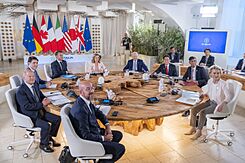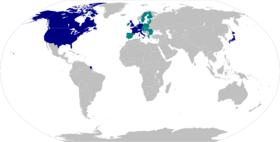G7 facts for kids
The Group of Seven (G7) is a special group of seven powerful countries: Canada, France, Germany, Italy, Japan, the United Kingdom, and the United States. The European Union (EU) also joins their meetings. These countries work together to talk about big global issues like trade, security, money, and climate change.
The G7 countries share similar ideas about how a country should be run, like having democratic governments where people have a say. They are also some of the world's major advanced economies.
The G7 started as a small meeting of money experts in 1973. Since then, it has grown into an important place where leaders from these countries meet every year. They discuss and try to find solutions for problems that affect the whole world. Even though the G7 doesn't have a formal treaty or a main office, it has a lot of influence. It has helped start important projects, like fighting HIV/AIDS, giving money to developing countries, and working on climate change through the Paris Agreement.
Together, the G7 countries have about 780 million people, which is almost 10% of the world population. They also hold about half of the world's total wealth and make up about 30% of the world's economy.

|
|

The G7-states (blue) and the EU (teal)
Member states and key leaders: |
|
| Formation |
|
|---|---|
| Founder |
Library Group:
|
| Founded at |
|
| Type | Intergovernmental organisation |
| Purpose | Political and economic forum |
|
Formerly called
|
|
Contents
How the G7 Started
Early Meetings
The idea for a group of the world's main industrialized countries came about before the 1973 oil crisis. In March 1973, George Shultz, who was the money chief for the United States, invited money experts from West Germany, France, and the United Kingdom to a meeting.
This meeting took place in the library of the White House in Washington, D.C.. Because of this, the first group of four countries became known as the "Library Group." Later that year, Japan was invited to join, and the group became the "Group of Five."
In 1974, many of these countries had new leaders. For example, the presidents of France and the United States, and the prime ministers of West Germany and Japan, all changed. So, the new U.S. President, Gerald Ford, suggested they all meet to get to know each other better.
First Big Summit and More Members

In November 1975, France hosted a three-day meeting for the Group of Five, and they also invited Italy. This created the "Group of Six" (G6). This meeting, held at the Château de Rambouillet, focused on big money problems like the oil crisis and a worldwide economic slowdown.
They created a plan called the "Declaration of Rambouillet." It said they would work together to support free trade and cooperate with developing countries. They also decided to meet regularly every year.
In 1976, Canada was invited to join the group. Canada was a large advanced economy, and its Prime Minister, Pierre Trudeau, had a lot of experience. This meeting became the first of the current Group of Seven (G7).
In 1977, the European Economic Community (now the European Union) was invited to join all G7 summits. Since 1981, leaders from the EU have attended every meeting.
What the G7 Does

The G7 was first created to help countries work together on money issues. The very first meeting focused on problems like the oil crisis in the 1970s. Since 1975, the group has met every year. The country that is in charge of the G7 that year hosts the main meeting.
Over time, the G7 started talking about more than just money. In the 1980s, they discussed international safety and conflicts, like the wars between Iran and Iraq, and the Soviet Union's actions in Afghanistan.
In the 1990s, the G7 helped poorer countries by reducing their debt. They also gave money to help fix the damaged nuclear reactor at Chernobyl. They also set up a group called the Financial Stability Forum to help manage the world's money system.
Helping Developing Countries
At the start of the 21st century, the G7 began to focus more on helping developing countries. In 1999, they helped create the G20, which is a similar group but includes the G7 and 13 other large economies. The G20 was made to help big industrial countries and developing countries talk to each other. Some people think the G20 might even replace the G7 one day.
In 2005, the G7 announced that they would reduce or cancel the debts of many poor countries.
Dealing with Money Problems
After the global financial crisis in 2007–2008, the G7 met several times. Many people around the world looked to the G7 for help and solutions. The money experts from the G7 promised to do "all necessary steps" to stop the crisis. They came up with a plan to help banks that were in danger of failing.
In April 2024, the G7 countries agreed to close most coal power plants by 2030-2035. They said this would happen unless the plants could capture their pollution or the countries found other ways to reduce their emissions to help limit global warming.
How Summits are Organized
The main G7 summit happens once a year, usually in June or July. The leader of each member country attends. The country that is the G7 president for that year is in charge of planning and hosting the summit. Each country usually hosts the summit once every seven years.
Besides the main meeting, many other meetings happen throughout the year. These meetings involve different government officials, like those in charge of money, environment, health, trade, and foreign affairs.
Who Leads the G7 Countries Now
The G7 is made up of the leaders of its member countries and the European Union. Here are the current leaders:
G7 Members: Key Facts
The G7 includes the seven wealthiest advanced countries. China, for example, has a very large economy, but it's not in the G7 because its wealth per person and its Human Development Index are not as high as the G7 members.
As of 2021, the G7 (without the European Union) holds about 53% of the world's total wealth. If you include the EU, it's over 60%. The total population of the G7 countries is about 10% of the world population.
| Member | Leader(s) | Minister of Finance | Central Bank Governor | |||
|---|---|---|---|---|---|---|
| Prime Minister | Justin Trudeau | Minister of Finance | Chrystia Freeland | Governor | Tiff Macklem | |
| President | Emmanuel Macron | Minister of the Economy and Finance | Bruno Le Maire | Governor | François Villeroy de Galhau | |
| Chancellor | Olaf Scholz | Minister of Finance | Christian Lindner | President | Joachim Nagel | |
| Prime Minister | Giorgia Meloni | Minister of Economy and Finance | Giancarlo Giorgetti | Governor | Fabio Panetta | |
| Prime Minister | Fumio Kishida | Minister of Finance | Shunichi Suzuki | Governor | Kazuo Ueda | |
| Prime Minister | Keir Starmer | Chancellor of the Exchequer | Rachel Reeves | Governor | Andrew Bailey | |
| President | Joe Biden | Secretary of the Treasury | Janet Yellen | Chair | Jerome Powell | |
| Council President | Charles Michel | Commissioner for Economy | Paolo Gentiloni | President | Christine Lagarde | |
| Commission President | Ursula von der Leyen | |||||
| Member | Economy Size (USD million) | Economy Size per Person ($) | Human Development Index (2021) | Population (2022-2023) | UN Security Council Member | Currency |
|---|---|---|---|---|---|---|
| Canada | 2,089,672 | 52,722 | 0.936 | 39,891,963 | Dollar | |
| France | 2,923,489 | 44,408 | 0.903 | 68,042,591 | Euro | |
| Germany | 4,308,854 | 51,383 | 0.942 | 84,270,625 | ||
| Italy | 2,169,745 | 36,812 | 0.895 | 58,815,463 | ||
| Japan | 4,409,738 | 35,385 | 0.925 | 124,470,000 | Yen | |
| United Kingdom | 3,158,938 | 46,371 | 0.929 | 67,026,292 | Pound | |
| United States | 26,854,599 | 80,034 | 0.921 | 334,748,000 | Dollar | |
| European Union | 17,818,782 | 39,940 | 0.899 | 446,828,803 | N/A | Euro |
| Total (excl. EU) | 45,915,035 | 59,072 | 0.922 | 777,264,934 |
Could More Countries Join the G7?
There have been many ideas about adding more countries to the G7. Some experts suggest making it a G9 by adding South Korea and Australia. They think this would make the group less focused on Europe and help deal with challenges from countries like China.
A group called the Atlantic Council has a forum called the D-10 Strategy Forum. It includes all G7 members plus Australia and South Korea. Some people see this D-10 group as a possible alternative to the G7. Other countries like India, Indonesia, Poland, and Spain also join as observers.
In 2019, Russia (which used to be part of the G8) said it would support adding China, India, and Turkey if Russia was allowed back into the group.
In 2020, the U.S. suggested adding Australia, Brazil, India, and South Korea, and bringing Russia back. However, the other six G7 members did not agree with this idea.
In 2021, the UK invited Australia, South Korea, and India to the G7 summit to bring more ideas and experience to the discussions. In 2023, Japan's Prime Minister Fumio Kishida invited South Korea, Australia, India, Indonesia, Brazil, Vietnam, Comoros, the Cook Islands, and Ukraine to the summit in Hiroshima.
Images for kids
-
The first G6 summit at the Château de Rambouillet in November 1975.
-
Flags of G7 members on University Avenue, Toronto (September 2016).
See also
 In Spanish: G7 para niños
In Spanish: G7 para niños
- Build Back Better World
- Capitalism
- D-10 Strategy Forum
- Developed country
- G4 (EU)
- G6 (EU)
- G8
- G8+5
- G10 currencies
- G20
- Great power
- Group of Twelve (G12)
- Junior 8
- List of country groupings
- List of G7 leaders
- List of multilateral free trade agreements
- OECD
- Quint
- BRICS














